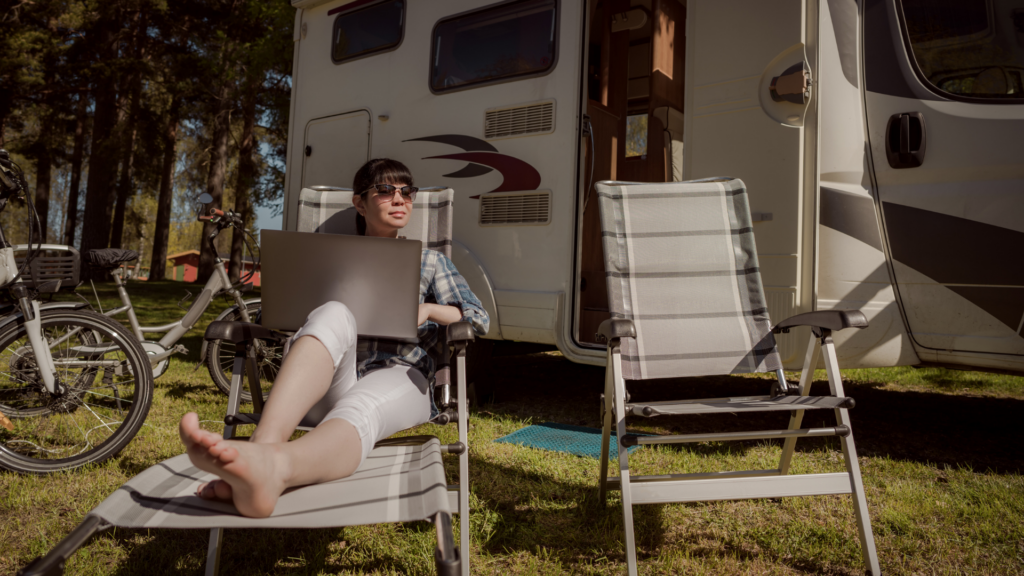Just because you’re camping or in an RV doesn’t mean you don’t want to stay connected. Video conferences and school work requires WiFi. Let’s look at the best way to get WiFi in an RV.
What’s the Best Way to Get WiFi in an RV?
The trouble with getting WiFi in an RV is that it changes from campground to campground, sometimes from one campsite to the next. If you’re relying on the campground’s WiFi, your campsite may be too far away from where the WiFi connection is. This can mean frequent disconnections or disappointing service.
If you come to a campground with your own WiFi, whether through a cellular or satellite-based connection, you may not get excellent service. Depending on the location of the nearest cell phone tower, mountains, trees, or other obstructions could cause a lackluster signal. Tree coverage can even impact satellite-based connections.
Using WiFi in an RV requires patience and a bit of flexibility. You may be able to suffer through camping with sub-par internet if it’s not essential. However, if you’re planning to do work or school while camping, not having WiFi access can have you packing up early.

RV WiFi Options
There are a few popular options when it comes to RV WiFi. Let’s look at each of them and see which one may be the best way to get WiFi in an RV for you.
Cellular Data or Mobile Hotspotting
Using cellular data or mobile hot-spotting is a fantastic option for getting WiFi in your RV. This option typically uses the same cellular towers that mobile phones utilize for service. This means if you know you can use your smartphone in your favorite campground, there’s a good chance you’ll be able to use a mobile hotspot there as well.
Pros and Cons of Cellular Data WiFi and Hotspotting
This is a great option to consider because if you already have a smartphone, you can likely transform it into a mobile hotspot. This allows you to connect laptops, tablets, and other electronics to your phone’s internet. You may not have to buy a designated device for hotspotting, which can be costly.
Service providers like Nomad Internet offer plans that use AT&T, Verizon, and T-Mobile. Whether you plan to camp at your local campground or travel the country, major providers have established networks across the country. You may need to stick close to populated areas to ensure you have a quality connection, but you’d be surprised at the speeds you can get, even in some remote locations.
However, one frustrating aspect of this option is that these plans typically have data caps or face restrictions regarding usage. You may find yourself camping in an area where your signal is excellent, but the network is congested. This means too many users are trying to access the internet at the same time. Despite an excellent signal, your internet speeds can slow to a frustratingly slow crawl.

RV Satellite Internet
RV satellite internet is much like a satellite TV service. It requires a clear view of the sky to connect with satellites that orbit the earth.
Pros and Cons of RV Satellite Internet
While satellite internet has been around for a while, it’s only recently become a decent option for RVers. By using satellite internet, you can access the internet globally, as long as you have a decently clear view of the sky. Starlink is one satellite service that’s becoming a more viable option every day.
Satellite internet provides coverage almost everywhere, but speeds are notoriously slow. What you gain in flexibility, you lose in speed. However, Starlink looks to change that by using satellites that orbit much lower.
Another disadvantage of satellite internet is that the equipment can be costly. Equipment can cost $500 or more, and monthly service fees can easily cost $100. We expect to see quite a bit of advancement in this industry as Starlink continues to launch more and more satellites and work out the kinks. Costs for equipment are likely to come down as they ramp up production to meet demand.
Campground and Public WiFi
If you’re lucky, your campground may offer an internet connection, or there may be public WiFi available nearby. Fast food joints, coffee shops, and public libraries are all great options to look for public WiFi too.
Pros and Cons of Campground and Public WiFi
Campground and public WiFi are great options because they won’t require any setup on your part. You may have to enter a password or agree to the terms of service, but you can be online in a matter of seconds. If you’re in a populated area, there are often many places that offer free WiFi.
However, there’s no guarantee that the service will be working or fast. You may find yourself connecting to public WiFi that’s slow or inconsistent. You might want to invest in a good WiFi Booster if you plan on using campground WiFi frequently. Another disadvantage is that it leaves you vulnerable to hackers and other security breaches. Using a VPN (a virtual private network) can help keep you safe while on public networks.
If Internet Is a Necessity, Have a Backup Plan (or 3)
For some people, accessing the internet while camping is nothing more than a luxury. However, for some, especially full-time travelers, it can be essential. If a quality internet connection is vital for you, you’ll want to have backup plans.
Your backup plans may be multiple cell phone plans across multiple carriers or a list of locations that typically offer WiFi. A campground may provide WiFi, but it may not be working. This means you’ll need to either have your own internet connection or have somewhere to go. One cell phone provider may have great service, but another could be non-existent. Having as many options as possible is the best way to avoid getting disconnected.

How to Determine the Right RV WiFiSolution for You
To determine the best way to get WiFi in an RV, first account for your needs. Your dependency on WiFi while RVing will greatly impact the number of places you can stay. If you require a zippy connection, you’ll be stuck camping close to populated areas or only in places known for good service. What tips do you have for finding the best way to get WiFi in an RV?

Leave a Reply